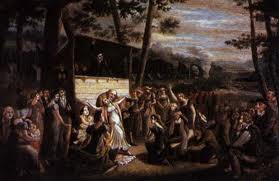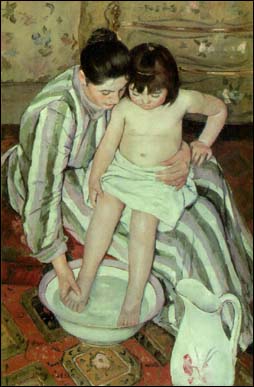Ex Church of Christ support groupHome * Website Purpose * History * UnBiblical Teachings * Spiritual Abuse Jesus' View of God * Faith & Works * New Covenant * The Pattern * Romans 14 |
||
|
______________________________________________ Who are the Churches of Christ? The Churches of Christ are an association of churches that trace their history back through the preaching of Barton W. Stone in the The Stone-Campbell Movement began as a unity movement in the 1790s (only a few years after the American Declaration of Independence in 1776). Alexander Campbell came from the Old Light Anti-burgher Seceder Presbyterian Church of Ireland and Scotland. Alexander Campbell's father, Thomas, rebelled against the rigidly closed taking of the bread and cup in his congregation in Ireland. Only those who passed the catechism were permitted to partake. No other Presbyterians who disagreed with their catechism were permitted to partake with them. (Some trace the Church of Christ penchant for debate and division to their Presbyterian/John Knox/John Calvin/Ulrich Zwingli heritage.) Campbell, born in 1780, was a postmaster/farmer/preacher who spread his teaching through magazines he edited.
In the early 1800s, fueled in part by the idealism of the new nation of the United States, the Churches of Christ/Christian Church/Disciples of Christ claimed to have been the fastest growing religious movement in the world at that time. Alexander Campbell was invited to preach to the Congress of the United States of America in 1850. Four preachers from the Churches of Christ, including Sydney Rigdon, joined the early Mormon Church around 1824 and influenced it to reflect several of the doctrines of the Churches of Christ (including the original name of the Mormon church, weekly communion, no professional clergy preacher over each congregation, and baptism for the remission of sins). The Restoration Movement split just before the American Civil War--the richer north opposing slavery and becoming more organized with a missionary society (1843) and adopting organs and pianos, (the Disciples of Christ). The southern portion retained an other-worldly approach and claimed to be the one true church (the Church of Christ). Some credit Daniel Sommer with fueling the split. Joining forces with David Lipscomb in Nashville, an abolitionist and pacifist, and editor, with Tolbert Fanning of The Gospel Advocate, an influential journal. A later editor of The Gospel Advocate, Foy E. Wallace, Jr., fought against premillenialism (the belief that Jesus would literally return to earth to reign for a thousand years) from 1930-1949, even though Alexander Campbell had founded the movement with a journal entitled The Millenial Harbinger. Restoration Movement groups go by the names of Church of Christ (using instrumental music, mostly in the west, associated with Midwest School of Evangelism in Ottumwa, Iowa), the Independent Christian Churches (the moderate middle of a conservative spectrum, sometimes called the Christian Church, and sometimes called the Church of Christ, especially in Canada and Australia), and the more liberal Disciples of Christ (who ordain gay clergy, and are active with the World Council of Churches) with headquarters in Indianapolis, Indiana. The O'Kelly movement of the Christian Church eventually joined the United Church of Christ (not identified with the Restoration Movement, but rather tracing history from the Calvinist Mayflower Pilgrim Puritans). The southern portion of the Restoration Movement became the Churches of Christ, non-instrumental. These churches claim 1.5 million adult members in 10,000 congregations in the USA. In other words, one in every 200 people in the United States is associated with the Churches of Christ, a cappella. This is down from 1.6 million members in 1980. Since 1980 the USA's population has grown by 36%, so the Churches of Christ as a percentage of the United States population has declined by 42%.
The Sunday School movement started in Geneva, Switzerland with John Calvin in 1536, and the Anglican Church adopted Sunday school in the 1780s to teach both children and adults, who worked in the factories six days a week, to read and write. Sunday School became strictly religious education after compulsory state education went into law in the 1870s in both England and the United States. Sunday school originally occurred on Sunday afternoons. In the United States it was enormously popular to send one's children to Sunday school on Sunday afternoons, in part because that was often the only time couples could be alone to perform their marital relations. Churches of Christ opposed most Sunday school movements because they were usually big interdenominational organizations with literature printing departments, something that the simple prairie churches opposed on the principle that each congregation had to remain independent of denominational oversight. Often there would be one Sunday school that served an entire town of mixed denominational children. In the 1930s, with the rising popularity of the automobile, American churches started to incorporate their Sunday school with their Sunday morning worship, either before or after, rather than after Sunday midday dinner. Churches of Christ followed suit, with publishing companies printing suitable literature exclusively for Churches of Christ. A small group of Churches of Christ opposed Sunday school for various reasons:
These churches also often opposed separate communion cups (which began in the Churches of Christ in the 1920s), drinking the communion out of one common cup, as Churches of Christ had done for over 100 years, as they believe Jesus originally instituted it, as the one cup at the Last Supper. The apostle Paul said "For we being many are one bread... drink from the cup of the Lord?"; They also often opposed located preachers (the pastor system), believing there was no authority for a located preacher, who became, like the denominations, a professional clergyman, the de facto leader of the congregation, vying with the congregation's elders for authority, in opposition to the way Paul instructed churches be organized. They also fiercely upheld the old Church of Christ doctrine that there be no clergy-laity distinctions. The One Cup movement became less and less powerful, until they now comprise 44 congregations. (My mother grew up in a one cup congregation.) In the 1950s and 1960s 7-10 percent of the non-instrumental or a cappella Churches of Christ split off in the United States over para-church organization and money distribution. (Can a group of churches pool money to do a special ministry like an orphan's home or a national radio show?) The smaller, non-institutional churches probably number close to 100,000 adult members, and use Florida College, in Tampa, Florida, as their school for higher education. I grew up in the non-institutional Churches of Christ. They argued that the Churches of Christ split off from the Christian Church in the 1840s because of the formation of a missionary society and central convention. Why then were Churches of Christ a hundred years later doing the same thing? From 1979 to 2001, the fastest growing wing of the Movement was the International Church of Christ, with roots in Gainesville, Florida, headquartered in Boston, then in Los Angeles. This group started out as a campus ministry, asking for "total commitment" to Christ. Their major focus is converting people. This movement split into three groups, around 2002, one joining the evangelical movement but lacking a clear vision, one continuing the hard line control of converts (Discipling Movement), and one "sold out" group remaining with the original founder, Kip McKean, the International Christian Church. Since the 1970s there has been a growing house church movement in the Churches of Christ, many of them leaving the non-institutional Churches of Christ (see also here), often focusing on the doctrine of grace. About 10% of mainstream Churches of Christ are unhappy with the direction the Churches of Christ are going, and are ready to split off again. The larger a cappella Churches of Christ are identifying with the wider evangelical movement (which often looked to Billy Graham for leadership) and some of them are adopting instrumental music in their worship services. The churches ready to split off oppose instruments of music, oppose unity with denominations, oppose the teaching of evolution in their colleges, and oppose higher criticism in interpreting the Bible, as taught by Abilene Christian University graduate school. These hard line churches wish to remain the One True Church. The Churches of Christ tend to split approximately every 30 to 40 years. All of the hard line Churches of Christ combined probably number about 200,000 to 250,000 people. A friend of mine was a preacher in a Detroit suburb. He pointed out to me how one could trace the evolving doctrines of the Churches of Christ since 1910 by looking at the Church of Christ buildings built in the suburbs that formed concentric circles around Detroit as the automotive industry grew. As the suburbs expanded farther away from central Detroit, the churches closer to Detroit were more conservative, old style, and the Churches of Christ located in the suburbs farther away from Detroit became more relaxed, more like a main stream Baptist congregation. Currently the Churches of Christ are shrinking by 2% per year (the same rate at which the larger evangelical movement is shrinking). The only portions of the Churches of Christ that are growing consistently are newer hard line Hispanic and immigrant congregations. Churches of Christ are part of the Greater Appalachian and Deep South communities as illustrated in this map by Colin Woodard. They are rarer in Yankeedom, New Netherlands, the Far West, and New France. See also this interactive Google map.
______________________________________________ |
For more on Stone and Campbell click here.
There is also a sizable group in Australia called the Churches of Christ that traces its roots to the Restoration Movement. They use instruments of music, and are much more moderate than Churches of Christ in the USA, being similar to the Independent Christian Church/Disciples of Christ in the USA.
There are many splits and divisions within the a cappella movement. Perhaps the most conservative and restrictive wing of the Churches of Christ is a tiny group of churches in the American Midwest that refuse to hire full-time ministers. There are also groups that refuse to have separate Bible classes in the church building (because it constitutes division), some who will only use the King James Version of the Bible, and some who use only one cup for communion. |
|
 American mid-western frontier, an ex-Presbyterian preacher heavily influenced by Methodists and Shakers, and
American mid-western frontier, an ex-Presbyterian preacher heavily influenced by Methodists and Shakers, and 
 The Stone-Campbell Movement, or more familiarly called the
The Stone-Campbell Movement, or more familiarly called the  The Churches of Christ were originally pre-millenial. One of the
The Churches of Christ were originally pre-millenial. One of the 

